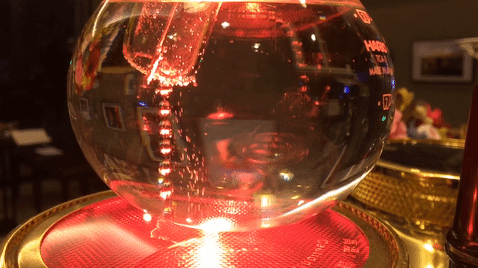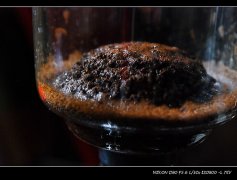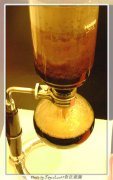Why is the siphon kettle called the plug Pot siphon Coffee Pot tutorial on how to use it and its skills

Professional coffee knowledge exchange More coffee bean information Please pay attention to coffee workshop (Weixin Official Accounts cafe_style)
In winter, plums are broken, a pot of siphon gold is brewed, and the sun is basked on the heater ~ siphon pot
Siphon-type coffee pot, also known as the tournament pot, it originated in Germany. The principle is to heat the gas in the lower pot, increase the pressure, and push the water to the upper pot to extract coffee. Siphon pot is currently in Japan is a very popular coffee brewing method, and now the rise of domestic use siphon pot.
directory
1 Method of use
2 Skills
3 process
use method
Siphon pot shape similar to gourd-shaped glass pot, the upper and lower halves can be disassembled,[1] and the middle is connected by a conduit. Boiling water is poured into the bottom half of the pot and the pot is heated with an alcohol lamp. Filter paper or filter cloth will be placed in the upper half of the siphon pot, and then coffee powder will be placed in the upper half. When the water in the lower pot starts boiling, you can insert the upper pot into the lower pot. Alcohol is generally used to heat the bottom of a siphon pot made of pure glass. At present, some siphon pots are equipped with steel sheets at the bottom of the lower pot, which can be used with induction cookers. When the water in the kettle is heated, it will be converted into steam, and the pressure on the water surface will increase. Boiling water then enters through the conduit to hold the ground coffee. Then re-enter the lower part through the filter paper or filter cloth, and then pour out the lower half of the coffee to drink. [2]
skills
Professional siphoning coffee cooking, depending on the climate, humidity, room temperature, bean species and roasting degree of a variety of stirring or water treatment techniques. Siphon coffee is often cooked with a medium to light roast, because its indirect warming and longer steeping methods can reflect the finer coffee layers and fruit sweetness, compared to the heavy roast coffee aroma, oil aroma is different. Because siphoning techniques require experience, siphoning coffee is often mistaken for poor coffee cooking. The rough state of overcooking is as follows: bitter taste comes from excessive extraction (overcooking or burning of beans due to excessive water temperature), astringent taste comes from prolonged soaking, and sour taste comes from excessive stirring. However, experienced and master the appropriate siphoning caffeine, its higher temperature cooking method, can completely extract the sweetness and gum of coffee, so that the mouth is always fragrant and full of sweetness.
process
Siphon pot, full name siphon siphon. Invented by a woman named Nabia in the mid-19th century, it was refined into its present form in the 20th century.
Steps 1 through 7 of the animation.
Step 1: Water is heated in a glass jug until it boils and emits white smoke.
Step 2: Place 2-3 tablespoons of ground coffee in the glass container above.
Step 3: Insert the upper glass container into the top of the glass jug.
Step 4: The water gradually rises due to the pressure of steam, rising to a water ratio of 2:1 (upper pot 2, lower pot 1), removing the fire source, gently stirring the coffee powder in the pot with a wooden spoon, so that the coffee powder is evenly wetted for about 1 minute.
Step 5: Observe whether there is an upward rush (whether the connecting pipe bubbles), move back to the fire and continue to cook until the water has risen completely, turn off the fire and remove the stove from the lower pot.
Step 6: Use a wet cloth to wrap the pot gently to quickly cool the temperature of the glass pot, so that the coffee liquid gradually flows back to the pot due to temperature and pressure changes.
Step 7: After the coffee is cooked, the glass bottle located at the top will return to the glass container below due to vacuum suction (temperature and pressure).
。
Important Notice :
前街咖啡 FrontStreet Coffee has moved to new addredd:
FrontStreet Coffee Address: 315,Donghua East Road,GuangZhou
Tel:020 38364473
- Prev

Syphon brewing check table plug air kettle siphon siphon coffee brewing parameters suggestion reference
Professional coffee knowledge exchange more coffee bean information please follow the coffee workshop (Wechat official account cafe_style) winter plum fold, make a pot of siphon gold manning, bask in the sun by the heat ~ siphon syphon is easy to learn, the extraction rate is high, it is easy to boil the extract, and the cease-fire point is difficult to grasp, this is the most important problem, and it also causes many people to learn syphon.
- Next

Is the plug pot a siphon pot? how to use the plug pot to make a good cup of coffee
Professional coffee knowledge exchange more coffee bean information please follow the coffee workshop (Wechat official account cafe_style) winter plum fold, brew a pot of siphon gold Manning, bask in the sun by the radiator ~ siphon in order to let the coffee release the most perfect taste, Joyce decided to use the air stopper to carefully brew good coffee. Siphon or Syphon is also called glass ball or siphon.
Related
- What is the Philharmonic pressure? How to use Philharmonic pressure to make delicious coffee
- Why does a hand grinder have more fine powder than an electric grinder?
- In addition to the hot mom, what is the difference between the versions of EK43 | ditting and Mahdi ek43?
- What kind of equipment do you need to make coffee by hand? Introduction to novice starter cooking equipment tools
- Espresso needs to be ground how thick and thin scale entry Italian Coffee Machine Bean Grinder investigation and Grinding course
- How much does it cost to open a small private cafe? How much does it cost to learn coffee? How to operate it?
- The difference between the flavor characteristics of hand-brewed coffee and coffee maker is hand-brewed coffee really better than coffee maker? Can I use a coffee machine to make coffee beans by hand?
- The difference between 01 and 02 of hario v60 filter cup what is the difference between 01 and 02 filter cup opening and cooking flavor
- What's the difference between the smart cup and the French kettle? Which is better, the French kettle or the Smart Cup?
- What's the difference between a smart cup and a V60 filter cup? The difference between the taste of smart cup and hand-brewed coffee

